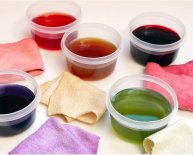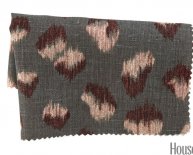
Dye for silk
Choosing your silk dye
Since silk can be dyed with almost any sort of dye, you need to decide which properties are most valuable for you in your current project. Are you most concerned that the dye be completely non-toxic for small children, or that it be particularly easy to apply, or that the dyeing process not alter the texture or luster of your silk even a little?
Non-toxic. Most of the dyes mentioned on this web site are not significantly toxic, but they are not safe to eat, either. If you want to use a dye that's safe to use your good (non-aluminum) cooking pots for, and still be able to use your dye-pots for food, then you should use food coloring. Food coloring is not the brightest, most predictable, wash-resistant, or fade-resistant of dyes. However, it is safe to use in your good cooking pots, and it is safe to use with small children, children who are too young to follow standard safety practices. If you'd like to use food coloring to dye silk, see the page Using Food Coloring as a Textile Dye for Protein Fibers.
Many people imagine that natural dyes are the safest type of dyes to use, but in fact natural dyes can bring their own hazards; natural dyes are usually less safe to handle than food coloring, as textile dyes, and most are less suitable for dyeing baby items than fiber reactive dyes.
No heating and no steaming. If your primary concern is to avoid investing right now in a dyepot, or to avoid bothering with simmering or steaming your dyes, then you should use a cool-water fiber reactive dye, such as Procion MX type dye. You can dye any washable silk with the same soda ash recipe we use for dyeing cotton with Procion MX dyes. It's perfect for tie dyeing, batik, low water immersion dyeing, dye painting, or any other form of direct dye application. It can also be used to dye silk in the washing machine. The only drawback is that the soda ash will make the silk a little less shiny and a little softer; sometimes this is desirable, but if your number one priority is to maintain the stiff texture and shiny luster of your silk, then you should use some sort of acid dyes, instead, although they will require some heating.
Alternatively, there is a way to fix Jacquard Green Label Silk colors at room temperature without the use of a high pH; these dyes are mixed to have an acidic (low) pH, although they are Remazol fiber reactive dyes.
Wash-proofness. The best dyes for staying bright even after washing are the cold-water fiber reactive dyes, such as Procion MX, when used with soda ash, and the Lanaset dyes when used as directed. The metal complex dyes, such as KraftKolour's Premetallised Acid Dyes, are also very good. (In fact, some of the Lanaset dyes are metal complex dyes.) If you want an extremely long-lasting, wash-proof dye that does not make your silk a little softer, use Lanaset or metal complex dyes, both of which must be used either in a boiling dyebath or with steam-setting afterwards.
Good for silk painting. Any of the dyes mentioned above, with the exception of the food colorings, are good for silk painting, but you will have to mix your own colors. Procion MX dyes should be used within a week of mixing, but the other dyes stay good in water for up to a year, or in some cases longer.
The silk dyes known collectively as the French Dyes are available pre-mixed in a wide variety of colors in small jars. They are known for their brilliant colors as compared to the pigment-based fabric paints that are used in silk painting. Some of the colors are basic dyes (with poor lightfastness), some are reactive dyes, some are acid dyes, and some are metal complex acid dyes. The different brands of the French dyes include Dupont, Pebeo Soie, Sennelier Tinfix, and Kniazeff. They require lengthy steaming to fix them, three hours instead of the thirty minutes required for Remazol and Procion H dyes.
The Remazol dyes are very cost-effective when used as silk paints; you can set them after they dry by steaming the silk for half an hour. Both Remazol and Procion H dyes are considered to be less toxic alternatives to the French dyes, though it is impossible to do a direct comparison since in most cases there is no way to find out which dyes are included in the French silk dyes.
True colors. The dyes that are mixed for use on cotton will in many cases produce unexpectedly different colors on silk, because the dyes in the mixture may each work a little better or worse on silk than on cotton. Mixtures of Procion MX dye colors are the worst for color predictability when used with soda ash, but more predictable when used as acid dyes, with citric acid or vinegar instead of soda ash, though the pure unmixed colors of Procion MX will produce very nearly the same color on every fiber. The best dye choices for absolutely predictable colors on silk are the Lanaset dyes, the acid dyes, and the French silk painting dyes such as Tinfix, Pebeo Soie, and Dupont. My own favorite black dye for silk is the Lanaset Jet Black, which is a very rich deep black that is highly wash-resistant.
How to Apply Your Silk Dye
Once you've chosen your silk dye, you must acquire any necessary auxiliary chemicals, and decide on your method of dye application.

















